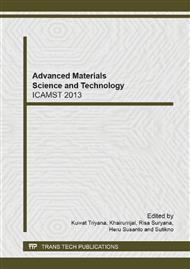p.668
p.672
p.676
p.681
p.687
p.695
p.701
p.706
p.710
Effect of EDTA and PYP as Co-Ligand of Radiolabeled Nanomaterial M41S-NH2 for Radiosynovectomy
Abstract:
Radiosynovectomy is an innovative medical treatment for rheumatoid arthritis joints. A small amount of beta-emitting radiopharmaceutical is injected into the joint with intra-articullar route of administration. An ideal radionuclide for this treatment is beta emitter whose minimal gamma ray emission, tissue penetration between 5 10 mm, has short half life, high chemical purity and non-toxic properties such as Rhenium-188. For delivering the radionuclide to the specific target site in the synovial tissue and preventing the leakage to the lymph, an ideal carrier as particulate or colloidal compounds is requaired. A silica-based nanomaterial called M41S-NH2 was developed as therapeutic carriers by Polytechnic Institute of Nuclear Technology, Yogyakarta. The advantage of M41S-NH2 is biocompatible and not toxic to human body. As a preliminary experiment, M41S-NH2 was labeled using Technetium-99m which has a similar chemical properties with Rhenium-188. The radiolabelling performed in this system is the indirect method. The purpose of this research is to obtain the highest radiochemical purity of radiolabeled 99mTc-M41S-NH2 by using two co-ligands such as ethylenediaminetetraasetic acid (EDTA) and sodium pyophosphate (PYP). Some parameter such as pH, ratio of SnCl2 to co-ligand, ammount of reductor agent, ammount of M41S-NH2 were optimized in those experiments. Radiochemical purity determination was conducted by ascending paper chromatography method using Whatman 31-ET as stationary phase and physiological saline (NaCl 0,9%) as mobile phase. The optimum condition obtained from the investigation were by using 10 μg PYP as co-ligand, 10 μg SnCl2 as reductor agent, pH 9, and 10 minutes in room temperature as incubation time. More over the highest radiochemical purity obtained from those labeling experiments is 93.42± 0.06 %.
Info:
Periodical:
Pages:
687-694
Citation:
Online since:
February 2014
Keywords:
Price:
Сopyright:
© 2014 Trans Tech Publications Ltd. All Rights Reserved
Share:
Citation:


